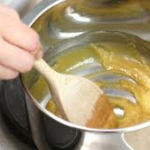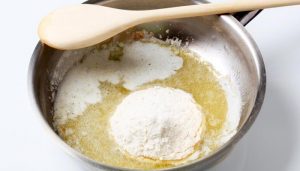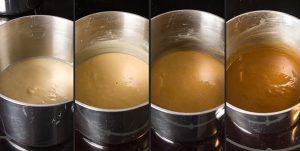14 Oct How to Make Roux 01

|
|
|

|
Here are the general instructions for making a basic Roux to thicken products such as soups, stews, sauces and items cooked to order in a sauté pan or pot. I'm using and crediting allrecipes.com for this Step-By-Step presentation that offer the basics of how to make a good, proper roux, and the several varieties most commonly used. For the four basic types of Roux, White, Blonde, Brown and Dark Brown, I will offer individual recipes germane to the recipe in question; for example, I will offer a link to my Roux (White) 01 for use with a White Wine Sauce, or Roux (Dark Brown) 01 for use with my Gumbo recipe.
|
From allrecipes.com, by their Staff, no date given. http://dish.allrecipes.com/how-to-make-roux/
Roux (pronounced “roo”) is a thickener for sauces and soups that combines equal parts flour and butter. Pre-cooking flour allows the starch granules to swell and absorb moisture, and lets you thicken a sauce base without the flour clumping or forming lumps.
While you might not know the term, you know the technique: a basic white sauce, such as the base for macaroni and cheese, starts with a roux.
Made by cooking a flour and oil paste until the raw flavor of the flour cooks out and the roux has achieved the desired color, a properly cooked roux imparts silky-smooth body and a nutty flavor while thickening soups and sauces.

Roux can be made with a variety of oils and animal fats. They are commonly made with vegetable oil, olive oil, or clarified butter, but can also be made with bacon grease or other rendered fats. Since an oil-based roux will separate as the flour settles to the bottom, clarified butter is the preferred fat to use when making a roux for future use, as it will harden when refrigerated, trapping the flour in suspension. This suspension helps to prevent lumps when the roux is whisked into a sauce or soup. Having a well-made roux on hand will make it easy to use this marvelous thickener in everyday cooking.
There are four varieties of roux: white, blond, brown, and dark brown. The different colors are a result of how long the roux is cooked; white is cooked for the shortest time, while dark brown cooks the longest. White and blond roux are the most common, used to thicken sauces, soups, and chowders. Brown and dark brown roux have more flavor, but less thickening power than white or blond roux. These roux are primarily used in Cajun and Creole dishes, most notably gumbo and jambalaya.
While none are better or worse than the others, it does affect flavor and how much the roux can thicken. Roux begins to thicken soon after it is combined with a liquid, but it must be simmered for 10 to 20 minutes in order to reach its full flavor and thickening potential. This additional cooking time allows the flour to soften and absorb the liquid, resulting in a silky smooth soup or sauce. If the simmering time is too short, the flour in the roux will remain grainy.

- Begin making the roux by melting 1 cup of clarified butter in a saucepan over medium heat. Once the butter is hot enough that a pinch of flour sprinkled into it will slowly start to bubble, proceed to the next step.
- Whisk 1-3/4 cups of flour into the clarified butter until a thick, rough paste forms. Whisk constantly while it bubbles over medium heat. As it cooks, the roux will become smooth and begin to thin.
- The white stage is reached once the flour looses its raw smell, after about 5 minutes of cooking and stirring. Although slightly grainy in texture, it is much smoother than it was at the beginning. The mixture is bubbling vigorously and the color is a little paler than when the clarified butter and flour were first combined.
- After about 20 minutes of continuous cooking and stirring, the roux will reach the blond stage. The bubbles are beginning to slow, and the aroma has taken on nuances of popcorn or toasted bread. The roux is now tan colored, very smooth, and thinner than it was at the white stage.
- Brown roux will reach a peanut butter-brown color after approximately 35 minutes of cooking and stirring. Its aroma is more pronounced and sharper than the nutty nuances of blond roux. The roux is now thinner, and the bubbling has slowed even more.
- Even darker than brown roux, the dark brown stage occurs after about 45 minutes of cooking, and is the color of melted milk chocolate. Its aroma will also mellow from the strong, roasted flavor of brown roux and will actually smell a little like chocolate. The roux is no longer bubbling, and is very thin.
- Carefully pour the finished roux onto a baking sheet and place in the refrigerator to cool.
- Refrigerate the roux for several hours or overnight until it has hardened completely. Once hardened, it is easily pried off of the baking sheet and broken into pieces. If you used oil or a fat other than clarified butter, the flour may settle to the bottom, and the oil will rise to the surface. Stir the oil back into the flour before using as this will make the roux dissolve smoothly. If you decide to pour off the oil, the roux will still work, but will require more whisking into a sauce in order to fully dissolve.
Roux will keep indefinitely when stored in the refrigerator or freezer in an airtight container. Roux made with vegetable oil can be stored at room temperature for several weeks, but roux made with butter or fat should always be refrigerated. With perfectly prepared roux always on hand, making luxuriously silky soups and sauces will be a breeze!
Content and Photos by Allrecipes.
My Roux Type Links:
Roux (White) 01
Roux (Blonde) 01
Roux (Brown) 01
Roux (Dark Brown) 01


